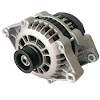Functions of Transmission Lines and Distribution Lines
Transmission Lines: The transmission lines are mainly
used to deliver bulk power from power stations to the load centres and large industrial
consumers. Depending upon the operation voltage these are mainly divided into
two types, namely
1.
Primary Transmission Lines:
In this, the operating voltages
are 132Kv, 220Kv, 400Kv (or) even 765Kv which depends upon the distance, the
amount of power to be transmitted and the system stability from the generating
station.
2.
Secondary Transmission Lines:
The primary Transmission line
transmission line terminates at the receiving station (RS) which is usually
lines at the outskirt of the city. At the receiving station the voltage is
reduced to 33kv (or) 66kv by using step-down transformer. From this station,
electric power is transmitted at 33kv (or) 66kv to the various substations.
Distribution Lines: Distribution lines are used to deliver the power from substation, to the
various consumers. Depending upon the operation Voltage, these are mainly dived
into two types, namely
1. Primary Distribution Lines
2. Secondary Distribution Lines
1. Primary Distribution
Lines: The secondary
transmission lines terminate at the substation (SS) where the voltage is
reduced from 33kv (or) 66kv to 11kv, 3-phase, 3-wire. This 11kv line is
supplied to bulk industries and also run along the important road sides of the
city. This whole system of arrangement is called primary Distribution
2. Secondary
Distribution Lines: The
electric power from primary distribution line (11kv) is delivered to
distribution substation (DS). These substations are localities and step – down the
voltage to 400 Volt, 3-phase, 4-wire for secondary distribution. The voltage
between any two phase is 400 Volt and between any phase and neutral is 230
Volt.
Need for Transmission and Distribution Lines
The electrical power supply undertakes the following aims,
namely
- Supplying of electrical power to the consumer within the specified limits frequency. (49Hz – 51Hz).
- Supplying
of electrical power within the specified limits of voltage (eg. Variation with
in +5%)
- Supply
of energy at low cost.
- Maximum
security of supply and minimum fault duration.
- Supply
of required amount of power to all types of consumers over’s the Specified area
at all times continuously.
- Generally
the power generating stations are far away from the urban areas where consumers
are located. Hence, in order to fulfil the above tasks, an extensive network of
conductors between the power station and consumers is required. This network
mainly comprises of two lines called transmission and distribution lines.









0 Comments